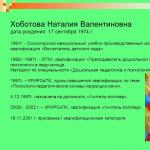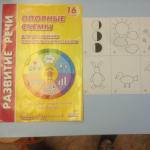Support schemes for the development of coherent speech in children
Support schemes for the development of coherent speech in children
The study of the influence of learning on the mental development of a child takes an important place in child psychology and preschool pedagogy. The effect of the impact of training is directly dependent on its content and means. Numerous studies of domestic teachers and psychologists (,) show that the use of modeling as a means of forming a variety of knowledge and skills has a positive effect on the intellectual development of children, that with the help of spatial and graphic models, orientational activities are relatively easily and quickly improved, promising intellectual and practical actions are formed ...
"MODELING" - the study of any phenomena, processes by building and studying models. Modeling by its object has models.
"MODEL" is any image (mental and conditional; images, descriptions, diagram, drawing, graph, plan) of any process or phenomenon (the original of this model), used as a substitute.
In preschool pedagogy, modeling is used to familiarize children with nature, in the process of developing speech, mastering elementary mathematical concepts, and developing children's musicality. The peculiarity and significance of modeling lies in the fact that it makes visible the properties, connections, relations of objects hidden from direct perception, which are essential for understanding facts, phenomena in the formation of knowledge that are attached to concepts in terms of content.
The availability of the modeling method for preschoolers has been proven by psychologists (,). It is determined by the fact that modeling is based on the principle of substitution. A real object can be replaced in the activity of children by another object, image, sign.
In didactics, there are 3 types of models:
1. An object model in the form of a physical structure of an object or objects, naturally connected (a plane model of a figure, reproducing its main parts, design features, proportions, the ratio of parts in space).
2. Subject-schematic model. Here, the essential components identified in the object of cognition and the connections between them are indicated with the help of objects - substitutes and graphic signs.
3. Graphic models (graphs, formulas, schemes).
In order for the model as a visual and practical means of cognition to fulfill its function, it must correspond to the series requirements:
Clearly display the basic properties and relationships that are the object of knowledge;
Be easy to perceive and accessible to create actions with it;
Brightly and distinctly convey with its help those properties and relationships that must be mastered;
Facilitate cognition (,).
In the psychological and pedagogical literature, a number of regularities in the formation of modeling in preschoolers are highlighted:
Modeling is performed on material familiar to children, based on knowledge gained in the classroom or in everyday life;
It is advisable to start with the modeling of single specific situations, and later - with the construction of generalized models;
One should start with iconic models, that is, preserving a certain similarity with the modeled object, constantly moving on to conditionally symbolic images of relations;
You should start with modeling spatial relationships, and then move on to modeling temporal, logical, etc.;
Modeling training is easier if you start with the use of ready-made models and then build them;
The process of teaching modeling ends with the internalization of actions, that is, with the transfer of planning into an internal plan.
The above facts direct attention to the development and application of subject models in teaching, which, of course, serves as a means of streamlining, systematizing the child's experience. Self-construction of models testifies to the degree of formation of internal, ideal forms of modeling, which represent the core of mental abilities. The assimilation of logical forms of thinking is necessary in the future, in the course of schooling.
One of the main tasks of a preschool institution is to teach children a coherent speech, that is, the ability to clearly and consistently express their thoughts. The main tasks of the GCD for the development of speech are the following: expanding and clarifying the range of ideas about objects and phenomena of the surrounding reality; development of children's observation through systematic exercises; mastering the language, its grammatical structure, the communicative function of communication.
The main principles of organizing GCD with preschool children, along with general didactic ones, are the objectivity and visibility of teaching, which develops the orientation of teaching.
Objectivity is understood as the organization of training in such a way that the studied subject is, as far as possible, perceived by all the senses: hearing, sight, touch, smell, tactile sensations. Objectivity presupposes sequential replacement of a living, natural object with a subject-schematic model.
One of the factors that facilitate the process of becoming coherent speech, according to the opinion, is visibility... The visualization of teaching involves the use, in addition to natural objects, of various options for visual means: pictures, drawings, tables, diagrams, technical teaching aids.
The developmental orientation of teaching involves the use of methods and techniques that involve the development of the child's higher mental functions: perception, memory, attention, thinking, etc. Examination of objects, pictures helps children to name objects, their characteristic features, actions performed with them.
The creation of plan of speaking... A well-known psychologist pointed out the significance of this fact. He noted the importance of sequential placement in the preliminary program, the scheme of all concrete elements of the utterance, as well as the fact that each link of the utterance should be replaced in time by the next.
The tasks of the teacher include not only acquainting the child with the world around him, but also teaching methods of examination, observation, the ability to highlight the essence, to establish relationships. Reference diagrams, visual models, symbols are very useful in this process.
Many practicing teachers have had to deal with a situation where, when asked to talk with older preschoolers on a topic (fruits, transport, professions, animals, times of goal, etc.), there is a pause at first. Then the children talk about one or two characteristic features of the subject under discussion, and again there is a pause. Further, children often begin to repeat the answers of their comrades, adding minor changes from themselves. There is a feeling that they have not memorized anything from the passed topic, did not understand, from them it is necessary to "pull out" everything. But this is not the case. They learned and remembered a lot, but they cannot express it correctly, according to the plan.
The child meets early enough with symbols, models, schemes: signs in a transport store, road signs, color design of services (ambulance, fire service, traffic signals), car icons, etc. All this attracts the child, he quickly and easily remembers these symbols, understands their meaning. Therefore, the use of support schemes by the teacher in the work will help children to highlight the main thing, to find relationships.
What are reference circuits? Support schemes are the conclusions, the result, the essence of the material that the child must learn. Schemes, symbols, models should be "born" before the eyes of children at the time the teacher explains new material in the form of drawings, schematic images, tables.
The purpose of the reference schemes is "... to present the material under study so that, on the basis of the logical connections of the material (topic), it becomes accessible, imprinted in long-term memory" (), facilitates memorization. Support schemes are like a rod on which material is strung. Not a frozen model, but a system constantly supplemented with new material.
The preschooler is deprived of the opportunity to write down, make a table, mark anything. In the classroom in kindergarten, only one type of memory is mainly involved - verbal. Support schemes are an attempt to use visual and motor memory to solve cognitive tasks, to include the associative memory of jokes, joy, discoveries, gestures that accompanied the presentation of the material.
Children often have difficulty in the following :
Independent determination of the main properties and attributes of the subject;
Establishing the sequence of presentation of the revealed signs;
Keeping this sequence in mind, which is the outline of the story-description.
To avoid these difficulties, it is necessary to use schematic models to compose descriptive stories about toys, vegetables, birds, animals, dishes, clothes, seasons, transportation, etc.
Steps for working with reference circuits
There are several stages in working with reference circuits:
1. Introduction of elements, symbols. For example, the notation:
□ colors; □ forms;
□ quantities; □ actions.
2. The use of elements of reference schemes, symbols for all types of GCD, in various activities.
The child should not be "addicted" that this symbol is applicable only in one area. The symbol is universal.
3. Introduction of negatives.
For example, notation: □ not round; □ not edible https://pandia.ru/text/78/538/images/image003_62.gif "width =" 148 "height =" 43 src = ">
5. Independent search by children for images that symbolize some quality.
The task of this stage is an active search for images, the ability to argue your choice. So, for example, it was the children who were prompted by the image of two glasses: full and crossed out empty when drawing up a reference diagram for the structure of an arithmetic problem (the answer must be complete).
6. Creative creation of support schemes by children.
(According to the story of a teacher or friend, an individual sketch of plans, schemes, riddles.)
Difficulties with reference circuits
When using reference schemes, symbols, children cannot always abstract themselves from the symbol, a conventional image, they begin to talk about the elements of the scheme, and not about the subject of knowledge, discussion.
This problem occurs in individual children at stages 1, 2, 3 and does not last long. Also, work can be difficult at 5-6 stages due to the small visual experience of children, and at a younger age - due to ignorance of letters, numbers, signs.
To overcome some shyness and uncertainty in the search for symbols by the children themselves, you can use the "sketch" of riddles. Such sketches cause noticeable animation and joy. For example:
No windows, no doors, no hands, no ax
the upper room is full of people. (Cucumber) Built a hut (Nest)
You can offer children an assignment for a collective search, discussion of images of joy, grief, wind, light, etc.
The use of reference circuits in various activities.
Supporting schemes, symbols have long been included in life and teaching in kindergarten (nature calendars, duty corners). The versatility of reference schemes and symbols allows them to be used very widely. For example, when familiarizing with the world around them, nature, the teacher invites children to make sketches of symbols on separate small sheets of paper, which must then be arranged in order and fastened together. You can use one marked and numbered sheet or sheet in the form of an "accordion book." The main thing is that the child does not have problems in the sequence of the first image and then the use of the material. As a rule, children value their "author's" books. in the children's library of the group, you can give them a place.If you decide to arrange a children's work as a book, do not forget about the cover, where the child can write its name, his name (author), and if he does not know how to write, draw what it is about (animal , transport, fruit, etc.) Here is an example of a "record" of the topic "Vegetables":
A man sows seeds in the ground, looks after them, and then harvests vegetables. "

When reading fiction, a sketch of the sequence of events, characters, characteristics of heroes, etc. can be used.
With the use of reference schemes, training can take place in the preparation of creative, descriptive stories, stories based on a plot picture. For example: "Compose a story. You see its middle in the picture, but you do not see what happened before and how the story ended. These parts of the story must be invented."
https://pandia.ru/text/78/538/images/image006_36.gif "width =" 441 "height =" 299 ">
1. Colour... The first square contains red, yellow, blue and green color spots. It is important that they do not have a clear form recognizable by children, then attention is better concentrated on color and there is no shift in the concepts of color-form.
2. The form... The second square contains geometric shapes. They are not painted so that the attention of children is concentrated on their shape. If the shape of the described toy is complex (doll, lunar rover), this item is omitted, and the corresponding part of the diagram is covered with a sheet of white paper.
3. The quantity... 2 toys of contrasting size are drawn in the square. Children are reminded that, in addition to the concept of "big - small", it is necessary to use the concepts "high - low", "long - short", "wide - narrow", "thick - thin".
4. Material. On this part of the sheet are glued 3 rectangles of the same size made of metal foil, plastic, wood-like film. They represent the material accordingly.
5. Parts of the toy. Several pyramid rings are drawn separately. If the toy is solid, it is not divided into parts, then this item is omitted.
6. Actions with a toy. Shown is a hand with fingers spread apart. Since manipulations with toys can be very diverse, it is important to use antonyms and other methods of expanding the verb vocabulary of children when explaining this point to children.
It will not be difficult for the teacher to choose toys, in the description of which all points of the diagram will be used. This is a pyramid, a matryoshka, a box with a mosaic, a stroller for dolls, etc. Later, when the children master the scheme well, you can give toys that do not use all the items in the description, for example: ball, jump rope, cube, bear, doll, etc. . NS.
An example of a story based on a diagram written by a 5-year-old child.
This ball is multi-colored, it is round in shape, large, you can't even grasp it with your hands. It is made of plastic, and it is not the same as rubber, softer rubber. You can throw the ball up and play football, or roll it on the ground, but you cannot play with the ball in a group - you can break glass.
Description of garments
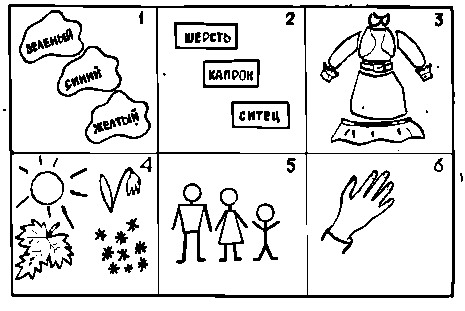
1. Colour. There are 3-4 color spots in a square: red, yellow, blue and green.
2. Material. 3 pieces of fabric (wool, chintz, silk or nylon) of the same shape and size are glued onto the cardboard. Naturally, before compiling descriptive stories about clothes, it is necessary to conduct classes with the children to familiarize themselves with the named and other materials, so that the children can examine them, touch and remember the names of the fabrics.
3. Parts of clothing. A sundress or suit is depicted, all parts of which (collar, cuffs, sleeves, frill, belt, etc.) are at a short distance from each other. Children are introduced to the names of all the details of the costume in advance.
4. Seasonality of clothing. A sun, a snowdrop, a yellow maple leaf and a few snowflakes are drawn in the square, which symbolize summer, spring, autumn and winter, respectively.
5. Who is the clothing for? Symbolic images of a man, woman, boy and girl.
6. Actions with clothes. Shown is a hand with fingers apart.
Here is an example of a dress description according to this scheme.
This dress is red with white polka dots. It is very beautiful. It is wool, in my opinion. Have dresses with long sleeves, a beautiful lace collar, beautiful red ties ... and lace on the cuffs, and pockets with circles. Leather belt with a plastic buckle ... You can wear this dress and in winter, and in spring, and in autumn ... Well, in summer you can, when it's not hot. It is best to wear it when visiting ... This is a dress for a girl. And what can you do with it? Hang on a hanger, iron it if it gets wrinkled, and if it gets dirty, wash it.
It should be noted that even at the highest level of speech development without schemes, children are not able to compose such detailed descriptions.
Description of utensils
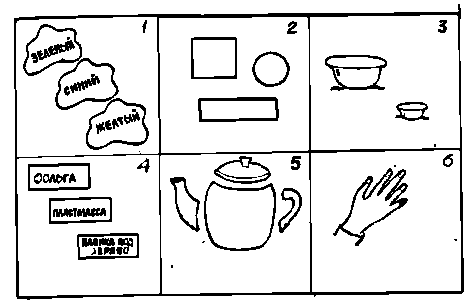
1. Colour. In a square there are 3 - 4 color spots.
2. The form. A square, a circle, and a rectangle are outlined. If children are already familiar with three-dimensional shapes - on a sheet of images of a cylinder, a ball, etc., preschoolers can use these terms when describing objects.
3. The magnitude. Large and small bowls are drawn.
4. Material. Rectangular pieces of the same size made of foil, plastic and wood-like film are glued to the cardboard. They represent a variety of materials from which the dishes are made. In addition, with the children, it is clarified that the bulk of the dishes are made from clay and porcelain, materials that are difficult to display on the diagram. Wooden, metal, glass, plastic dishes are also considered, compared by touch, by weight, by the sound produced, etc.
5. Parts of utensils. A kettle is depicted, parts of which are at a short distance from each other. Children are reminded of the names of tableware parts: bottom, walls, handle, lid, spout, etc.
6. Actions with dishes. The hand is depicted.
Let's give an example of a child's description of a large teapot according to this scheme.
This is a kettle. It is large, all white, and on the walls and on the lid are painted red rowan branches ... and also a gold strip on the lid and on the spout. The kettle is round, pot-bellied. It is large, you can pour a lot of water into it, probably on 10 man is enough. This teapot is made of clay and then painted with paint. Have The kettle has a bottom, a spout, walls, a lid, a handle on the side and a handle on the lid. Tea is poured into a kettle, then boiling water is poured, and then poured into cups for guests. With this kettle, you need to be careful ... well ... carry it, otherwise you will break and yet you will burn your feet.
Description of the seasons
Free time "href =" / text / category / vremya_svobodnoe / "rel =" bookmark "> free time. These are systematic observations of the state of nature and weather, for their change. As experience shows, words denoting abstract concepts associated with natural phenomena , for example, cloudy sky, drizzling rain, withered grass, etc. - you need to repeat it many times so that they are included in the child's dictionary.
1. The sun. In the first square of the diagram, a sun disc with rays is drawn. Children talk about the sun at certain times of the year: it shines but does not warm, it often happens behind the clouds, it warms hot etc.
2. Sky. This part of the sheet depicts a blue sky with clouds. Children should tell what kind of sky they most often see at one time or another of the year: clear, cloudless or gray, cloudy, covered with clouds, etc.
3. Earth. A piece of land with grass on it is drawn. Children talk about how the earth looks at different times of the year: covered with snow or damp from rain, the grass on it is dry and yellow, or the first grass appears on it, etc.
4. Trees. 2 trees are depicted (without leaves). It is better not to paint conifers, because their appearance is the same in all seasons. Children talk about deciduous trees at different times of the year: leaves on trees turn yellow, fall off; kidneys appear; covered with bright green foliage NS
5. People.(seasonal clothing) WITH A man and a woman are symbolically depicted. A hanger is drawn at the top of the square. This means that it is necessary to talk about changes in people's clothing and the reasons for this phenomenon. For example: it is cold in winter and people wear winter coats and fur coats, warm hats and boots, mittens and scarves etc.
6. Beasts.(seasonal changes in the life of wild animals) Outlined 2 animals familiar to children, for example, a hare and a squirrel. The child talks about the changes in the life of animals depending on the season. For example: beasts in the forest does not have enough food, they hibernate; animals store food for the winter, change their "fur coats" etc.
7. Birds.(seasonal changes in the life of birds, classification) 2 birds familiar to children are depicted in outline, for example a crow and a swallow. Children reflect in the story seasonal changes in the life of birds. For example: prepare for departure or build nests, hatch chicks etc.
8. Activities for children.(games, labor) In the square is a snowman, a net and a boat. Children tell what they do on the street at one time or another of the year: collect dry leaves, ski, make a snow woman, swim in the river etc.
Description of vegetables and fruits
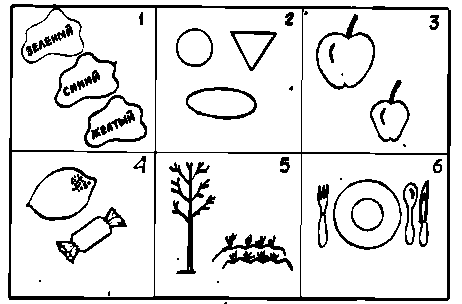
1. Colour. Color spots are drawn in the square.
2. The form. Geometric shapes: circle, triangle and oval.
3. The magnitude. 2 fruits of contrasting size are depicted, for example a large and a small apple.
4. Taste. Drawn candy and lemon, contrasting products.
5. Place of growth. A tree and a garden are depicted.
6. How is it used v food. Shown are plates, forks, spoons and knives. In preliminary work with children, it is specified which vegetables and fruits are eaten raw, which ones are boiled, fried, canned, fermented, pickled, etc.
Here is an example of a story composed by a child according to the scheme.
Green cabbage, round. It can be very large and heavy, and sometimes it is smaller. It tastes a little bitter. Cabbage grows in the garden, right on the ground itself. Have she has a lot of clothes and all without fasteners. A they eat raw cabbage, I always eat when my mother cooks soup, that is, cabbage soup. They also cook borscht from cabbage, and salt it ... and here they also make a hodgepodge of cabbage.
The use of diagrams in the preparation of descriptive stories greatly facilitates the mastery of this type of coherent speech. In addition, the presence of a visual plan makes such stories clear, coherent, complete, consistent. Model schemes can be used not only for composing descriptive stories, but also for comparative stories, coming up with riddles about objects and puzzles, as well as in such an important and complex section of work as teaching children to ask questions on their own.



